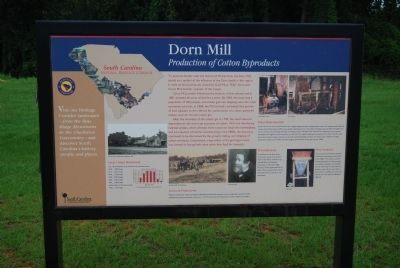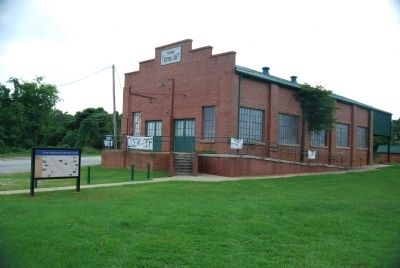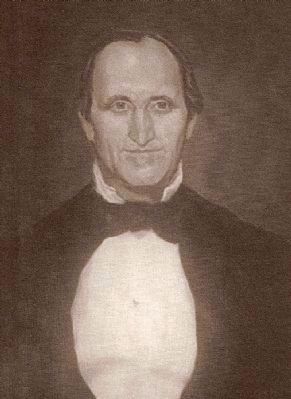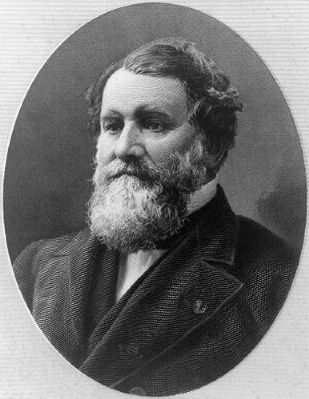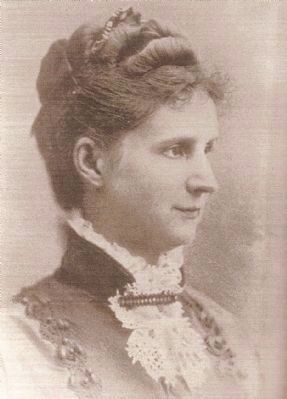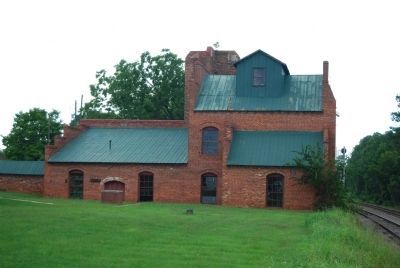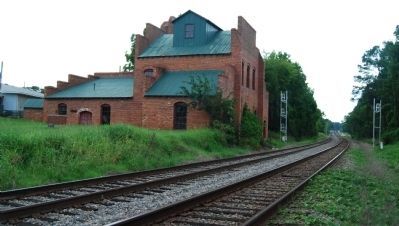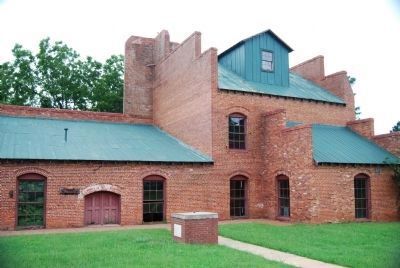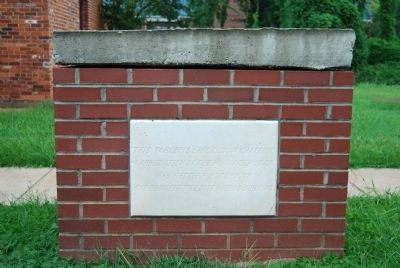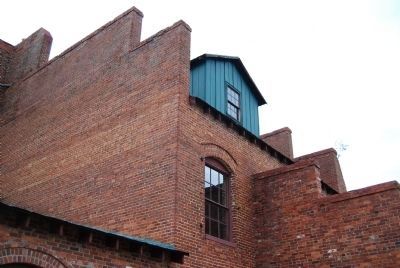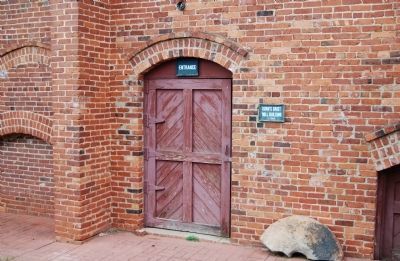McCormick in McCormick County, South Carolina — The American South (South Atlantic)
Dorn Mill
Production of Cotton Byproducts
To persons familiar with the history of McCormick, the Dorn Mill stands as a symbol of the influence of the Dorn family in the region. It rests on land previously owned by Gold Mine "Billy" Dorn and Cyrus McCormick, inventor of the reaper.
Cyrus McCormick influenced the location of the railroad and in 1881 donated 40 acres of land for a town. By 1883, this town had a population of 200 people, and cotton gins and shipping were the major economic activities. In 1898, the McCormick's conveyed this portion of land to the railroad for construction of a steam-powered cotton seed oil mill and cotton gin.
After the invention of the cotton gin in 1793, the south became dependent on the one-crop economy of cotton. With the developing railroad system, which allowed more cotton to reach the marketplace, and introduction of textile manufacturing in the 1880s, the economy continued to be dominated by the growth, milling, and shipping of cotton products. Cottonseed, a byproduct of the ginning process, was viewed as having little value other than feed for livestock.
Plant Modernization
By the time of the mill's transformation into a highly engineered plant utilizing steam power, the energy saving methods pioneered by Oliver Evans (1795) were widely implemented. Corn and wheat moved by cups and belts (vertically) and screw conveyors (horizontally) through the milling process. The plant only required two employees, one to power the boilers and engines and the second the run the mill. The related lumberyard (owned by M.G. and J.J. Dorn) across the tracks to the northeast continued to provide sawdust/shavings as fuel for the steam plants. When the milling production ceased in the 1940s, the steam engines powered the cotton gin into the 1950s.
Loss of Productivity
Planters continued to meet the industrial demands and paid little attention to land conservation practices which reduced the natural productivity of the soil. In 1919 the boil weevil introduced yet another disastrous problem.
Diversification
In response to the destruction of the main money crop, farmers finally made efforts towards crop diversification and livestock production. In the early 1920s, M.G. & J.J. Dorn (great-nephews of "Billy" Dorn) converted the mill for the production of meal, flour, and animal feed.
New Products
The cottonseed oil industry attained commercial importance in the South in the 1880s. The industry used the seed (a by product of cotton ginning) to produce marketable commodities such as: seed hulls for stock feed or fuel; linters for stuffing mattresses and pillows; and crude seed oil refined as edible oil.
Erected by
South Carolina Heritage Corridor.
Topics and series. This historical marker is listed in these topic lists: Agriculture • Industry & Commerce • Settlements & Settlers. In addition, it is included in the South Carolina Heritage Corridor series list. A significant historical year for this entry is 1881.
Location. 33° 54.791′ N, 82° 17.755′ W. Marker is in McCormick, South Carolina, in McCormick County. Marker is on North Main Street. Marker is along the sidewalk in front of the Old Cotton Gin building. Touch for map. Marker is in this post office area: Mc Cormick SC 29835, United States of America. Touch for directions.
Other nearby markers. At least 10 other markers are within 6 miles of this marker, measured as the crow flies. Dorn Mill Complex (here, next to this marker); Dorn’s Mill / Dorn Gold Mine (about 400 feet away, measured in a direct line); McCormick County / MACK (about 400 feet away); McCormick Passenger Train Steps (about 800 feet away); McCormick County Veterans Monument (approx. 0.2 miles away); McCormick Train Station (approx. 0.2 miles away); McCormick County Confederate Monument (approx. 0.2 miles away); Badwell / Badwell Cemetery (approx. 2.3 miles away); Welcome to Baker Creek State Park (approx. 4.1 miles away); Long Canes Massacre (approx. 5.2 miles away). Touch for a list and map of all markers in McCormick.
Also see . . .
1. Dorn's Flour and Grist Mill. South Carolina Department of Archives and History website entry:
Dorn’s Flour and Grist Mills is a two-and-a-half story red brick structure with projecting one-story wings. (Submitted on September 14, 2008, by Brian Scott of Anderson, South Carolina.)
2. Cyrus McCormick. Wikipedia entry:
Cyrus Hall McCormick, Sr. (February 15, 1809 – May 13, 1884) of Rockbridge County, Virginia was an American inventor and founder of the McCormick Harvesting Machine Company, which became part of International Harvester Company in 1902. (Submitted on November 25, 2009, by Brian Scott of Anderson, South Carolina.)
3. Nancy “Nettie” Fowler McCormick. Wikipedia entry:
Nancy “Nettie” Fowler McCormick 1835-1923, a well-known philanthropist, was the wife of Cyrus Hall McCormick (1809-1884). (Submitted on December 18, 2009, by Brian Scott of Anderson, South Carolina.)
4. Cottonseed Oil. Wikipedia entry:
Cottonseed oil is a cooking oil extracted from the seeds of cotton plant of various species, mainly Gossypium hirsutum and Gossypium herbaceum. (Submitted on December 13, 2009, by Brian Scott of Anderson, South Carolina.)
Additional commentary.
1. Facts About Dorn's Grist & Flour Mill
• Discovery Site on the South Carolina National Heritage Corridor.
• 3-story brick structure built in 1898 as a cottonseed oil mill.
• Converted to flour and grist mill in the 1920s.
• Contains the original steam engines and equipment (based on designs by Joseph Dart 1843) which were powered by sawdust and wood chips from Dorn Lumber Yard.
• Automated flour milling equipment (based on invention by Oliver Evans 1782).
• Saved from demolition in 1970s.
• Named to National Register of Historic Places July 12, 1976.
• Current restoration efforts sponsored by the Town of McCormick. Funded by SCDOT "ISTEA Enhancements", Dorn Mill Restoration Association, and private donations.
• Reopened scheduled to coincide with 100th anniversary in September 1998. (Source: Brochure published by the McCormick County Chamber of Commerce)
— Submitted September 14, 2008, by Brian Scott of Anderson, South Carolina.
2. Dorn's Flour and Grist Mill
Dorn's Flour and Grist Mill is a 2 1/2-story red brick structure with projecting one-story wings. Constructed ca. 1898 as a cotton gin, the mill is an outstanding example of rural industrial architecture. The extant steam engines and boilers date from the period when the building was used as a cotton gin, but the grist mill equipment dates from the 1920s.
Stepped parapets are incorporated on both one and two story sections. The corners of the building
are further supported by angle buttresses. Wide-gabled dormers on both the east and west facades project from the standing-seam tin roof. Dominant feature of the exterior is a three-story brick wall of cross-shaped plan which was built in 1915 to support a water tower. The tower provided back-up pressure for the boilers in case the steam water ejector pump failed. The tank has since fallen from its support, thereby causing extensive damage to the west wing.
From the railroad siding on the north side of the mill, hopper cars were loaded with grain and corn. A wooden channel extended from the 2nd floor of the elevator through the wall and over the siding. The exterior portion of this channel has since collapsed.
Exterior door and window openings are surmounted by segmental brick arches of two and three header courses. Window sashes are six-over-six lights, all of which are either missing or badly deteriorated.
The interior of the mill is its most salient feature. It is divided into five rooms on the first floor with two rooms in the upper section of the elevator. The structural system consists of 12" x 12" columns with chamfered edges supporting ceiling joists of the same dimensions. The exterior brick walls are load bearing, and all of the interior framework is exposed.
The southeast room houses the power plant for the mill: two one-cylinder steam engines and their boilers. These engines provided a source of power which was reliable, easily regulated, and cheap to operate. Dorn's Mill utilized wood chips from a local lumber yard for fuel. Both the steam engines and their boilers are intact, but the roof in this area of the building is deteriorating due to the collapse of the boiler exhaust stacks
The principal room of the mill is located on the first floor of the elevator section. In this area are located two large mill stones encased in a wooden platform, various pulleys and belts encased in wooden shafts, the grain cleaners, and the sacking machinery. The majority of this equipment is not encased, thereby exposing the thousands of mechanical components. The equipment that is enclosed is encased in wooden housings exhibiting fine quality mouldings and craftsmanship. The second floor features a flour dresser which separated the different grades of flour, and a corn cleaner which removed objects from the corn.
The shed room located east of the elevator housed the cotton oil machinery. The south wall of this room has collapsed, thus exposing the intricate machinery to the weather. The room west of the elevator contains six grain storage bins, but the roof is deteriorating due to the collapse of the water tank.
Significance
At one time many small towns throughout rural America utilized the services of mills similar to Dorn's Mill in McCormick, South Carolina. With the development of a more complex mill technology, many of these mills disappeared. Dorn's Mill is significant as one of only a few such mills still standing--its steam engines, boilers, and most of its machinery still intact.
Peter Cousins, Curator of Agriculture at Greenfield Village and Henry Ford Museum says:
"Dorn's Mill represents the rural locally based grist mill in adaptation to the new technology of milling. The irony, of course, is that the complexity and cost of modern milling led to the concentration of the industry...and the ultimate demise of small mills in other areas--such as Dorn's."
The actual construction date for Dorn's Mill is not known; however, there is evidence of its being built ca. 1898. Deeds are available which indicate a sale from a Mrs. McCormick to McCormick Enterprise Ginnery, Ca. (l898). In 1899 the property was purchased by the McCormick Cotton Oil Company; in 1902 by the Anderson Phosphate Company. In 1914 the "oi1 mill and ginnery p1ant" were sold to the Farmers Gin Co. In 1917 this property was conveyed to M.G. Dorn, J.S. Dorn, and Preston Findley who formed the Dorn-Findley Corporation. Its general purpose was to "operate, conduct and carry on an oil mill, cotton gin and grist mill." In the mid 1920s the Dorns hired a mill wright to
put in the present corn and wheat machinery as well as a hammer mill.
The mill operated throughout the years and ground commercial corn meal for sale in local and country stores, flour from wheat for local farmers (not for commercial sale) and chicken and animal feed.
The mill required one person to fire the boilers and operate the machinery. The boilers were fired with wood shavings brought by wagon from the planer mill and dumped through the large doors into the boiler room. Another person handled the milling operation weighing farmer's grain, grinding and sacking commercial meal, etc.
The mill closed in the 1940s. (Source: National Register nomination form.)
— Submitted December 13, 2009, by Brian Scott of Anderson, South Carolina.
3. About Cyrus Hall McCormick
Cyrus Hall McCormick, the famous inventor and manufacturer, was born at Walnut Grove, Virginia, February 15,1809. When he was seven years old his father invented a reaping machine. It was a rude contrivance and not successful. In 1831 Cyrus made his invention of a reaping machine, and had it patented three years later. By successive improvements he was able to keep his machines at the head of its class during his life. In 1845 he removed to Cincinnati, Ohio, and two years later located
in Chicago, where he amassed a great fortune in manufacturing reapers and harvesting machinery. In 1859 he established the Theological Seminary of the Northwest at Chicago, an institution for preparing young men for the ministry in the Presbyterian church, and he afterward endowed a chair in the Washington and Lee College at Lexington, Virginia. He manifested great interest in educational and religious matters, and by his great wealth he was able to extend aid and encouragement to many charitable causes. His death occurred May 13, 1884. (Source: A Biographical Record of Calhoun County, Iowa by S. J. Clarke Publishing Company (1902), pg 172.)
— Submitted December 18, 2009, by Brian Scott of Anderson, South Carolina.
4. About Nettie Fowler McCormick
In her teens, Nettie Fowler McCormick wrote, "I want to be somebody...During the past year, I have read many biographies of eminent individuals -- and while reading I have burned to be great and good. I will be." This strong drive to succeed led McCormick to become not only one of the earliest American businesswomen, but also one of the leading philanthropists of her time. She had a major role in the development of a great American invention, the mechanical reaper, as her husband's partner. After her husband's death, she used the profits to give away more than $8 million to institutions and individuals in America. (Source: Notable American Philanthropists: Biographies of Giving and Volunteering by Robert T. Grimm (2002), pg 207.)
— Submitted December 18, 2009, by Brian Scott of Anderson, South Carolina.
Credits. This page was last revised on March 18, 2024. It was originally submitted on September 12, 2008, by Brian Scott of Anderson, South Carolina. This page has been viewed 2,981 times since then and 69 times this year. Photos: 1, 2. submitted on September 12, 2008, by Brian Scott of Anderson, South Carolina. 3. submitted on December 8, 2009, by Brian Scott of Anderson, South Carolina. 4. submitted on November 25, 2009, by Brian Scott of Anderson, South Carolina. 5. submitted on December 18, 2009, by Brian Scott of Anderson, South Carolina. 6, 7, 8, 9, 10, 11. submitted on September 12, 2008, by Brian Scott of Anderson, South Carolina.
